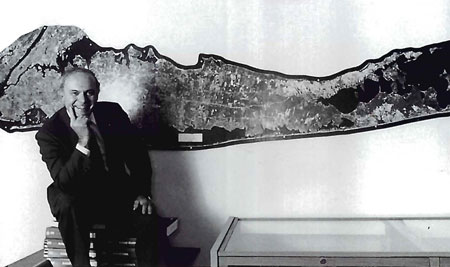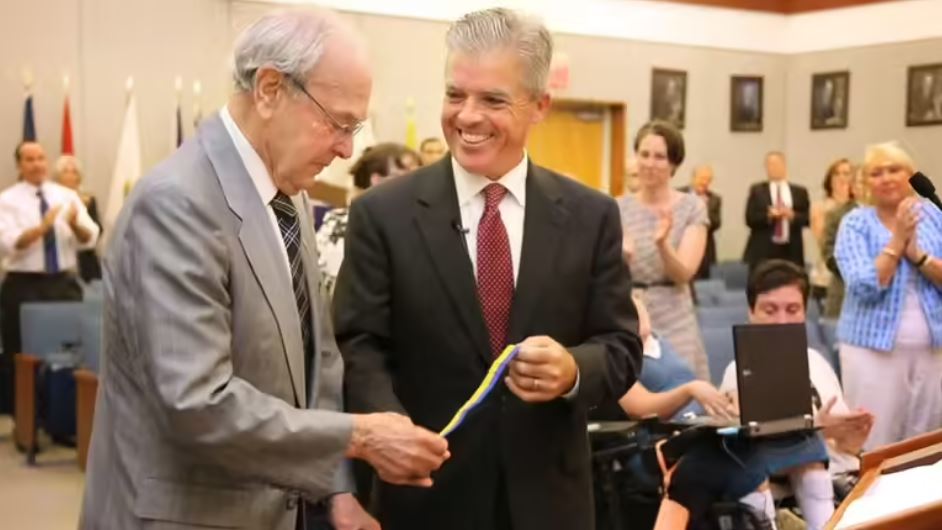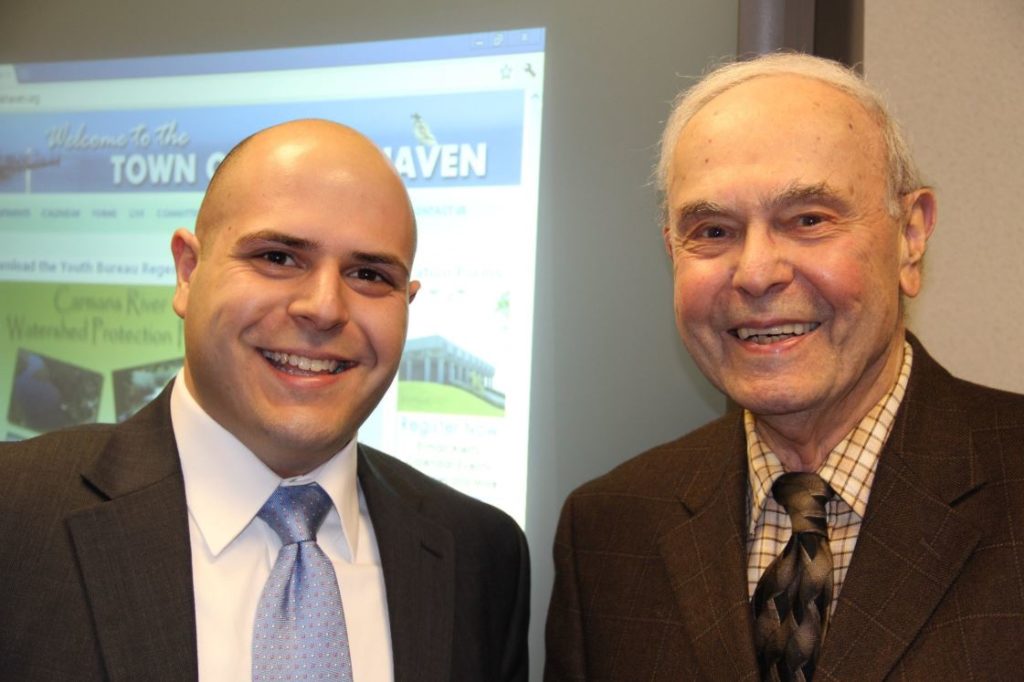The following was exclusively published by The Foggiest Idea on March 22nd, 2022.
BY RICHARD MURDOCCO
Lee E. Koppelman, the urban planner whose policies and plans shaped Long Island throughout the second half of the twentieth century, died on March 21, 2022. He was 94.
Together with H. Lee Dennison, the first executive to be elected to lead a newly minted Suffolk County government, the planner worked to build the framework of the county from the ground up. Koppelman, who was then a landscape architect and civic leader in Hauppauge, was hand-picked by Dennison to shape the then-blossoming locality’s administrative infrastructure from a shared desk that was housed within a dusty trailer.
From the preservation of the sweeping scenic farmland vistas that would eventually be seen by millions of visitors on the East End to ensuring that there would be clean drinking water each time parents turned on the tap faucet for their children, Koppelman’s lengthy and distinguished career touched every community across Long Island.

Pictured: Lee Koppelman, seen in 1988 in front of an aerial map of Long Island in the library at Stony Brook University. (Photo Credit: Stony Brook University)
Koppelman was the Director of the Suffolk County Planning Department from 1960 to 1988, a 28-year run across Republican and Democratic Administrations that remains unmatched in today’s era of partisan appointments.
From 1965 to 2006, Koppelman served as the executive director of the Long Island Regional Planning Board. During that time, he authored two intricate comprehensive plans that grappled with everything from the explosive suburban growth of the post-war era to the rumblings of a brewing environmental crisis due to Suffolk County’s lack of sewers. The studies captured the imagination of both the public and media, with his team’s findings often gracing the covers of Newsday.
Koppelman played a leading role in the preservation of Long Island’s open spaces, and was an early supporter for the preservation of open space and protecting farmland in Suffolk County. Thanks to his efforts, Suffolk County became the first local government in the U.S. to establish a formal program to preserve farmland through the purchase of development rights, an innovative new concept at the time that other suburban localities later emulated.
His research highlighted the interrelationships between developmental policy and the fragility of the Long Island region’s sole source aquifer, which provides potable water to 3 million or so residents.
The footprint of his work was enshrined in The Power Broker, the 1974 Pulitzer Prize winning biography of Robert Moses, where author Robert Caro noted the merits of the “young Lee Koppelman, a brilliant planner from Long Island.” To Caro, Koppelman served as an informative source who spoke on the nuances of Long Island’s development, standing in stark contrast to Moses “build first, ask questions later” mentality. For years, Koppelman’s personal copy of The Power Broker held a prominent spot on the planner’s bookshelf.
A third plan was later authored by Koppelman. While political squabbles at the time prevented it’s formal adoption, copies can still be found on the bookshelves of Suffolk County bureaucrats and policy wonks alike.
Parallel to his lengthy tenure in public service, Koppelman is also known for his work at Stony Brook University, where he served as executive director of the Center for Regional Policy Studies and taught into his final months as a Leading Professor and Professor Emeritus in the Department of Political Science.
Prior students of his include a who’s-who list of policy wonks, bureaucrats, and elected officials such as Kevin Law, who Governor Kathy Hochul recently selected to chair Empire State Development, to former Suffolk County Executive Steve Levy. He authored a series of books, including widely cited textbooks on the topics of urban planning and coastal zone science that are still read by students in university classrooms across the country.

Pictured: Suffolk County Executive Steve Bellone presents to Lee Koppelman the Suffolk Medal for Distinguished Service in July of 2015. (Photo Credit: Pam Robinson, County Executive’s Office)
As suburban sprawl gobbled up farmland early in his career, Koppelman’s calls to policymakers for increasing open space preservation and further diversity of housing types have since rung prescient.
“For all of his success in preserving open space, farmland, underground drinking water, and office park development, Lee was someone most dedicated to those around him,” said Seth Forman, Koppelman’s longtime colleague in Suffolk County and co-author of his book, The Fire Island National Seashore: A History. “He never forsook honesty and always afforded people respect. Lee was a rarity in public life: a nonpartisan, results-minded public servant, who garnered bipartisan support. His adherence to principle allowed him to survive as the master planner through eleven county executives.”
In the sunset of Koppelman’s career, there was a growing recognition of the historic significance of the planner’s work from elected officials.
In July 2015, Suffolk County Executive Steve Bellone awarded the planner the Suffolk Medal for Distinguished Service, the county’s highest honor. In 2018, Brookhaven Town Supervisor Ed Romaine and Councilwoman Valerie M. Cartright announced the dedication of a 46-acre heavily wooded parcel in Setauket as the Dr. Lee Koppelman Nature Preserve.
Lee Edward Koppelman was born on May 19th, 1927 in Harlem, New York. He grew up in Astoria, and later lived in Hauppauge, Smithtown, and Setauket. He earned a degree in electrical engineering in 1950 from the City College of New York, and followed his father’s trade to and became a successful landscape architect.
Once established, he got married and moved out to Suffolk County. There, he became active in the hamlet’s local civic group, where his work eventually caught H. Lee Dennison’s eye, who started his career in public service. Koppelman eventually received a Master’s Degree in Planning from Pratt Institute in the early 1960’s, and quickly followed up with a doctorate in Public Administration from New York University.
He is survived by Connie, his wife of nearly 75 years, as well as his children Lesli, Claudia, Laurel, Keith, and his grandchildren Ezra, Ora, and Dara.
LEARN MORE ABOUT LEE KOPPELMAN’S IMPACT ON LONG ISLAND
- Face the Future Now, Says Long Island’s Master Planner, Lee Koppelman The Foggiest Idea, Richard Murdocco, July 2015
- Lee Koppelman has been quoted numerous times throughout numerous articles in The Foggiest Idea‘s archives. You can read pieces featuring his thoughts here.
- The Master Planner’s Big Picture, New York Times, Bruce Lambert, May 1999
- Lee E. Koppelman, Master Planner, Long Island History Journal, Noel Gish, 2009
- Koppelman, a documentary created by Meghan Gallagher and Anna Smith, then-students within Stony Brook University’s School of Atmospheric and Marine Sciences (SoMAS), 2019













Thank you for sharing this Rich. The residents of Long Island, knowingly or unknowingly, will appreciate and benefit from the legacy that Dr. Koppelman has left to Long Island for generations to come.
I had the great fortune to know and work with Dr. Koppelman for many years and he was always very concerned over the balance between protecting the environment and promoting economic development, especially providing housing for all of our residents. It was an honor to work with him and his presence always made any meeting with us a most enjoyable and informative event.